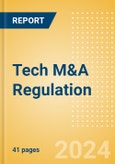Big Tech’s plans to use merger and acquisition (M&A) deals to strengthen its position and expand into other markets are being dashed by regulators’ antitrust activism. Large acquisitions are subject to heavy surveillance from regulators worldwide and aspiring acquirers need to pre-emptively address concerns from regulators and be ready to make concessions.
Merger control legislation is undergoing significant transformations, with regulators worldwide adopting a tougher stance on M&A enforcement. According to the EU’s Digital Markets Act (DMA), a digital gatekeeper can never be sure of whether or not its M&A activity will be reviewed by the European Commission, even if the acquired company is tiny. In the US, antitrust regulators are considering lowering the thresholds at which they will deem companies to have significant market power; the UK, India, and China are also considering more stringent obligations for large digital platforms’ M&A plans. These efforts will make it more difficult for Big Tech to get regulatory approval for further M&A activity.
Key Highlights
At the end of 2023, Adobe abandoned its planned $20 billion acquisition of Figma following opposition from UK and EU regulators. In January 2024, Amazon’s proposed $1.7 billion acquisition of iRobot collapsed in the face of EU scrutiny. Microsoft managed to close its $69 billion deal for Activision Blizzard in October 2023, but UK, EU, and US regulators are investigating its $13 billion investment in OpenAI, the company behind ChatGPT.Merger control legislation is undergoing significant transformations, with regulators worldwide adopting a tougher stance on M&A enforcement. According to the EU’s Digital Markets Act (DMA), a digital gatekeeper can never be sure of whether or not its M&A activity will be reviewed by the European Commission, even if the acquired company is tiny. In the US, antitrust regulators are considering lowering the thresholds at which they will deem companies to have significant market power; the UK, India, and China are also considering more stringent obligations for large digital platforms’ M&A plans. These efforts will make it more difficult for Big Tech to get regulatory approval for further M&A activity.
Scope
- This report provides an overview of the issues surrounding regulatory oversight of tech M&A deals.
- It includes analysis of the M&A regulatory landscape in the EU, US, UK, China, and India.
- It identifies the key trends impacting the theme over the next 12 to 24 months, split into three categories: technology trends, macroeconomic trends, and regulatory trends.
- It provides an overview of recent M&A activity in the tech, media, and telecom (TMT) industry and highlights mega-deals in TMT announced between 2020 and 2023 that are currently under scrutiny or likely to face scrutiny.
Reasons to Buy
- M&A deals can help companies improve efficiency and reach economies of scale, but they can also pose challenges to competition. Big Tech companies have aggressively pursued M&A activity, targeting start-ups with expertise and skills that they lack. Such acquisitions can significantly benefit consumers by supporting innovation. However, they can also raise concerns about competition when they remove potential competitors from the market or strengthen an already dominant position in a way that makes the entry of new players extremely difficult. This report will help you make sense of the issues around regulation of tech M&A. It also identifies the losers in the technology, media, and telecom (TMT) industry from the increased regulatory scrutiny of M&A deals over the next two to five years.
Table of Contents
- Executive Summary
- Players
- The M&A Regulatory Landscape
- Trends
- M&A Activity
- Companies
- Sector Scorecards
- Glossary
- Further Reading
- Thematic Research Methodology
Companies Mentioned (Partial List)
A selection of companies mentioned in this report includes, but is not limited to:
- Adobe
- Alibaba
- Alphabet
- Amazon
- Apple
- ASML
- AT&T
- Baidu
- Booking Holdings
- ByteDance
- China Mobile
- China Telecom
- Cisco
- Huawei
- IBM
- Meta
- Microsoft
- Netflix
- Nvidia
- Tencent
- Verizon
- Vodafone
- Walt Diseny
- X (Twitter)
- Yandex








